 |
|
|
|
History of 28cm K 5 Eisenbahngeschütz - page 2 |
|
|
|
|
| This was ignited by a time fuze in
the nose after 19sec flight. the rocket efflux passed down a central blast pipe to the
base of the shell, and the high explosive payload was packed around the blast pipe. Two
special graze percussion fuzes were mounted in the transom between the rocket motor and
the high explosive. A similar projectile with a conventional driving band, known as the R Gr 4341,
was developed for the K 5 Vz.
The next step was to adapt the gun to fire Peenemünder Pfeilgeschosse (Peenemünder arrow shells), and to do this the barrel was bored-out to become a 31cm caliber smoothbore, These guns, two of which were completed (one made by Krupp and the other by Hanomag), were known as the K 5 Glatt. |
|
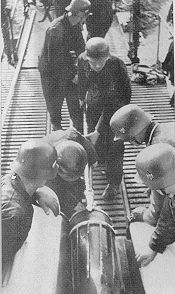 In addition to the four types that
entered service : In addition to the four types that
entered service : K 5 Tiefzug 10mm, K 5 Tiefzug 7mm, K5 Vielzug and K 5 Glatt, several other projects were mooted at various times during the war. In 1943 a contract was let to develop a screw-breech model to fired bagged charges; the development was done by Krupp but trials of the proposed system ended in failure. By that time the work on sliding block breeches for bag charges was beginning to show promising results, and further work on the modified K 5 was shelved to await further research. Another project was the provision of a muzzle brake in order to increase performance, but after the initial enthusiasm wore off this also fell by the wayside. |
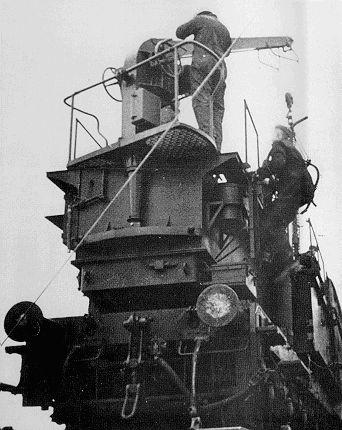 |
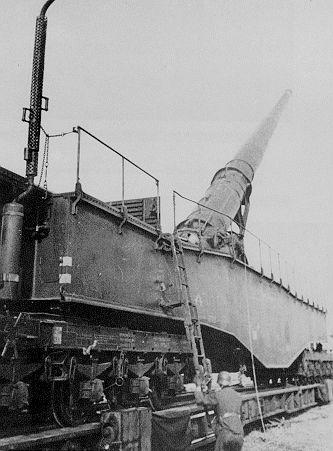 |
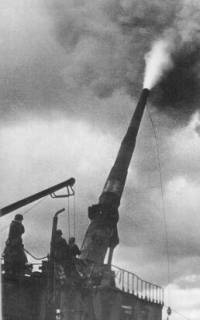 A most interesting
project was begun in 1943 at the instigation of the army. It was decided that, owing to
the increasing intensity of Allied air attacks, a railway gun should be developed that was
capable of cross-country detours around points at which the track had been destroyed. The
gun itself was also intended to carry an integral turntable platform so that it could be
lowered to the track and the bogies run clear, leaving the weapon ready to fire from the
platform with 360° traverse. This idea resembled the American 14 in M1920 railgun, but
the idea was then carried further by a suggestion that it should then be possible to
partly dismantle the K 5 and transport it across country on special
transporters based on the chassis and running gear of the Pz Kpfw VI (Tiger Tank). In
this, one transporter was to carry the breech mechanism, two were to carry the barrel
between them, two were to take the gun-carriage and one was to move the platform. The
mounting was also to be designed to take either the barrel of the 28cm K 5
or a new 38Cm howitzer with a planned range of 25000m(27340 yard) with an 800kg(1764lb)
shell. The whole project received a great deal of thought and would no doubt have been
successfully completed in due course, but it was still in the planning stage when the war
ended. A most interesting
project was begun in 1943 at the instigation of the army. It was decided that, owing to
the increasing intensity of Allied air attacks, a railway gun should be developed that was
capable of cross-country detours around points at which the track had been destroyed. The
gun itself was also intended to carry an integral turntable platform so that it could be
lowered to the track and the bogies run clear, leaving the weapon ready to fire from the
platform with 360° traverse. This idea resembled the American 14 in M1920 railgun, but
the idea was then carried further by a suggestion that it should then be possible to
partly dismantle the K 5 and transport it across country on special
transporters based on the chassis and running gear of the Pz Kpfw VI (Tiger Tank). In
this, one transporter was to carry the breech mechanism, two were to carry the barrel
between them, two were to take the gun-carriage and one was to move the platform. The
mounting was also to be designed to take either the barrel of the 28cm K 5
or a new 38Cm howitzer with a planned range of 25000m(27340 yard) with an 800kg(1764lb)
shell. The whole project received a great deal of thought and would no doubt have been
successfully completed in due course, but it was still in the planning stage when the war
ended. |
| Camouflage : The first four guns were overall dark Gray when they left the factory in 1937. They probably received camouflage when they were tested. Most of the period photographs I have seen showing this camouflage also show provisions for the Sprengwerk that was used only on the first three guns. The two tone scheme was in use from 1935 to 1939 and consisted of 2/3 dark gray and 1/3 brown. On K5, it was applied in broad undulating vertical bands (see Photo A). By the time K5's were delivered to the troops, the color scheme had changed to overall dark gray. They were sent to France and Russia in this delivery. During the Russian winter, K5's may have been whitewashed to camouflage then (see Photo B). The Afrikacorps used a dark desert yellow from 1942 onwards. Since Leopold was destined from north Africa it may have had this color. In early 1943, a three tone camouflage scheme was adopted, using a base of Dunkelgelb (dark Yellow). Dark brown and green could be added according to season and terrain. K5 guns seem to be found only in overall dark yellow, although the painting could be very motley. Lettering and badges were often left in patches of the original dark gray, as in the case on Leopold. |
|
Photo A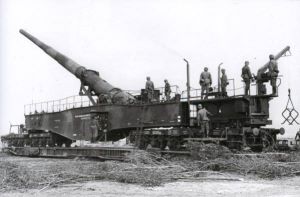 |
Photo B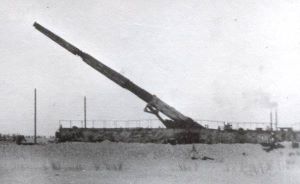 |
|
|
||||||
|
©
one35th - Last updated on :
Sunday, April 27, 2008 |
|||||